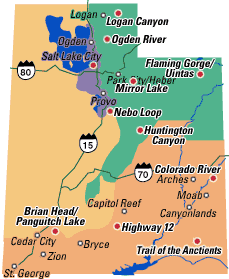 he was from the county of Rangárvallasýsla. Thor's grandmother, Hjálmfríđur Hjálmarsdóttir emigrated in 1891, also from Vestmannaeyjar.
he was from the county of Rangárvallasýsla. Thor's grandmother, Hjálmfríđur Hjálmarsdóttir emigrated in 1891, also from Vestmannaeyjar. We leave Provo early in the morning, it's a long drive ahead. Our first goal is the city of St. George, about 300 miles south of Salt Lake City. I'm really exited, I know from studying various websites that I may expect some thrilling landscape, especially in the "deep" south of Utah; the Dixie Utah. But - Why Dixie Utah? I know I don't have to tell you, it's more to refresh my own memory: When the Civil War broke out in 1861, the Mormon Prophet Brigham Young thought it would be necessary to raise cotton, if possible. Many of the early settlers of St. George originally came from the southern states. They came to the "Cotton Mission" to grow cotton, but they also brought with them a phrase for the area which became widely adopted--they called the St. George area "Utah's Dixie."
We arrive in St.George at noon. I call it "The Red City". In the outskirt of the city a bulldoser is turning up the ground and the the red color of the earth is overwhelming. The red color in the surrounding mountains is also dominating. Having been around in St.George for a while, we head for Zion, Utah's oldest national park. With nearly three million visitors per year, Zion is Utah's most heavily used park.
Driving around in the park is very much restricted so we did the best thing to do, parked the car and took the free Shuttle bus deep into the Zion Canyon. The conveniance with the shuttle bus is that you can
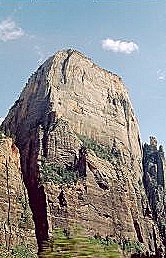
|
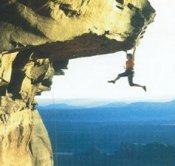 |
Hanging from a 2000 feet high tower of stone. From the film mentioned. Would you dare? |
We left Zion Park through a long tunnel carved high up in the massive canyon walls. Through some few "window-holes" was a spectacular view over the canyon. When through, we came to Mt. Carmel Junction and from there was a short drive to the village of Kanab, where we stayed for the night at the Victorian Charm Inn A great place to stay. The evening was spent at the Crescent Moon Theater where the Bar-G Wranglers entertained the guests with great Western Music like Tumbling Tumbleweeds, Cool Waters, Ghost Riders and many more.
The following day the Grand Canyon's Northern Rim was our first goal. From Kanab it's about 80 miles down to the canyon and shortly after we left Kanab we ran into a thunderstorm. I was wondering how it would be to overlook the Grand Canyon in such a heavy rainfall but fortunately the rain was over shortly after we reached Jacobs Lake and at the Rim the sun was shining at it's best.
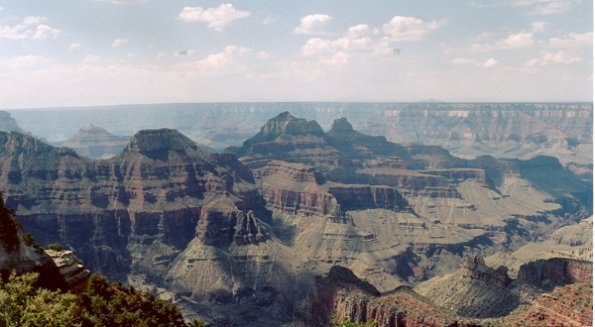
|
Standing at the Bright Angel Point and overlooking the canyon, you may wonder how many million years it has taken the Colorado River to carv it's way through this area. And ultimately the river carries the eroded material all the way to the Gulf of California.
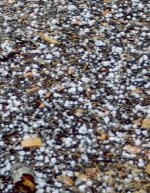 |
On our way back from he North Rim to Kanab, on the Kaibab Plateau, we ran again into a thunderstorm. There were lightnings all over and the heavy rain soon turned to a hailstorm. The hails that hammered the car were so big that we were afraid of that the car would be damaged so we drove, as many other cars did, under the branches of large trees at the roadside. The main storm may have lasted for half an hour when we set sail again and when back in Kanab, we could enjoy a good meal in the hot sun outside at a place called the Frontier Mowie Town. A very interesting place, really worth visiting.
There are many great national parks in Utah
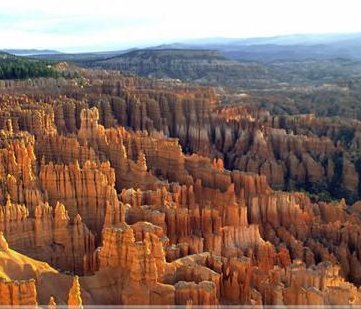
|
From Bryce Canyon we drove through the small towns of Tropic - a funny name for a town in a desert - Cannonville - humorously called Gunshot because it is not large enough to be a cannon :-) and Henrieville before we came to Escalante where we stayed for the night. The thunderstorm we had got into at the Kaibab Plateau, had struck Escalante with heavy rain and when we arrived a rescue team was still pumping water from the basement of some houses.
 |
Not ripe enough; the fruits I mean! |
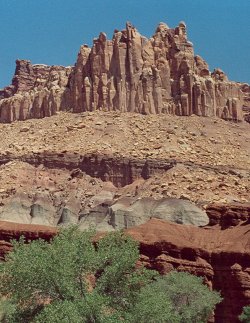 |
The following morning we headed for still another park, The Capitol Reef National Park. Before long we came to the town of Boulder and right outside the town is the Ansazi Indian Village State Park, which we must take a look at. This is an ancient village which was once home to one of the largest Ancestral Puebloan communities west of the Colorado River. An excellent visitor center displays artifacts found on the site. It's easy to spend hours there but we can't do that. Capitol Reef is not far away and when we enter this national park, the red color in the landscape becomes overwhelming. We pass interesting rock formations and sandstone walls with petroglyphs carved by the Fremont Indians who lived throughout Utah from A.D. 700 to 1300 before we come to the remnant of Fruita, an early pioneer settlement which rest in peace in Capitol Reef. The old town contains large orchards where fruit may still be picked in season. We were not at the right time for that but this is a lovely place.
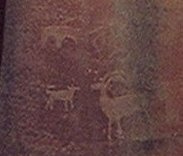 |
Touring South Utah with Thor Leifson was now coming to it's end. From Fairview is not a long road back to Provo where we had started three days earlier.
Before I left Utah for Iceland, David and Bonnie Ashby took me to Scofield, the old coal mining village in a beautiful surroundings, where some of the Icelanders had been working. Bonnie, a coalminers daughter, had grown up there before she left for Salt Lake City as a young girl. We visited the cemetery, but I did not find any "Icelandic" grave.
What's left is to thank this wonderful people who invited me to Utah and to their homes, David Alan and Bonnie Ashby and Thor and Loyce Leifson for their great hospitality and friendship. Flying home I was on cloud nine. This had been a fabulous trip. An inscription on a tombstone I saw in the Westerheim Pioneer Cemetery in Minneota came to my mind: "Eat dessert first, life is short and uncertain." Well, this Utah trip had been really a dessert and dessert is good anytime.

